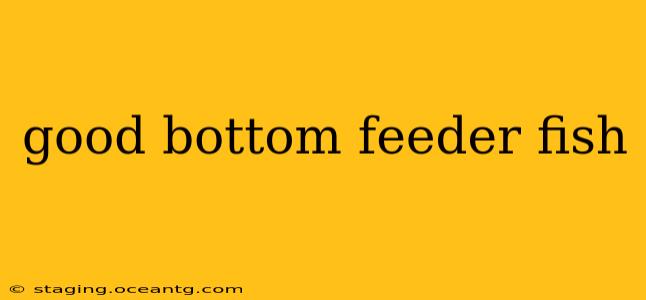Choosing the right bottom-feeding fish for your aquarium can significantly enhance its ecosystem and visual appeal. These hardworking inhabitants help maintain a clean and healthy tank by scavenging leftover food and detritus. But selecting the appropriate species requires careful consideration of tank size, compatibility with other fish, and individual care requirements. This guide explores some excellent bottom-feeding fish options, addressing common questions along the way.
What are the best bottom feeder fish for beginners?
For beginner aquarists, certain hardy and relatively low-maintenance species are ideal starting points. Corydoras catfish, specifically the Peppered Corydoras ( Corydoras paleatus), are a popular choice. These peaceful community fish are relatively small, remaining under 2 inches, and tolerate a wide range of water conditions. Another excellent option is the Siamese Algae Eater (Crossocheilus oblongus), known for its algae-munching prowess, although it’s crucial to note that adult specimens can become territorial. Always research the adult size of any fish before purchasing to ensure your tank can accommodate them.
What are some good bottom feeder fish for a 10-gallon tank?
A 10-gallon tank limits the size and number of fish you can keep. Smaller bottom feeders are best suited for this environment. Again, Peppered Corydoras are an excellent choice; a group of three or four thrives in a 10-gallon setup. Dwarf Corydoras species are also suitable for smaller tanks. However, avoid larger species that will quickly outgrow the space. Remember to account for the space needs of any other inhabitants you plan to add.
What are some large bottom feeder fish?
If you have a larger tank (55 gallons or more), you can consider larger, more impressive bottom feeders. Plecostomus (commonly called Plecos) are a popular choice, though it's important to remember that they grow very large – some species can reach over 2 feet! Therefore, thorough research into the specific species and its adult size is crucial. Other large options include certain types of catfish, such as the Redtail Shark ( Epalzeorhynchos frenatus), although their semi-aggressive nature necessitates careful tank mate selection. Ensure your tank is adequately sized and furnished with sufficient hiding places to reduce stress and aggression.
Are snails good bottom feeders?
Yes, snails are excellent bottom feeders, contributing to a clean tank environment. Nerite snails are a popular and relatively low-maintenance choice. They are efficient algae eaters and are unlikely to overpopulate your tank, unlike some other snail species. However, remember that snails also consume decaying plant matter and contribute to the biological filtration process. While they're beneficial, overpopulation can still be a problem, so responsible introduction is vital.
What are some peaceful bottom feeder fish?
Many bottom feeders are naturally peaceful, but some are more so than others. Corydoras catfish, as previously mentioned, are exceptionally peaceful community fish. Otocinclus catfish (Otocinclus affinis) are also generally peaceful, though they need algae-rich environments to thrive. Avoid fish known for aggression, like certain types of loaches or larger catfish, if you're aiming for a peaceful community tank.
What kind of bottom feeder fish eats algae?
Several bottom feeders are adept at controlling algae growth. Siamese Algae Eaters, as mentioned, are effective although they can become aggressive with age. Otocinclus catfish are also efficient algae eaters, but they require an established tank with adequate algae for their diet. Nerite snails are also excellent algae control agents. Remember that no single fish will entirely eliminate algae; good tank maintenance practices are still necessary.
This guide provides a starting point for selecting appropriate bottom-feeding fish. Always research specific species requirements before purchasing to ensure a healthy and thriving aquarium environment. Remember to consider factors such as tank size, water parameters, and compatibility with other inhabitants to create a balanced and harmonious ecosystem.
